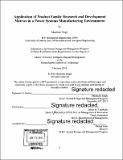| dc.contributor.advisor | James M. Utterback. | en_US |
| dc.contributor.author | Singh, Maninder, S.M. Massachusetts Institute of Technology | en_US |
| dc.contributor.other | Massachusetts Institute of Technology. Engineering Systems Division. | en_US |
| dc.date.accessioned | 2017-01-06T16:14:31Z | |
| dc.date.available | 2017-01-06T16:14:31Z | |
| dc.date.copyright | 2016 | en_US |
| dc.date.issued | 2016 | en_US |
| dc.identifier.uri | http://hdl.handle.net/1721.1/106266 | |
| dc.description | Thesis: S.M. in Engineering and Management, Massachusetts Institute of Technology, School of Engineering, System Design and Management Program, Engineering and Management Program, 2016. | en_US |
| dc.description | Cataloged from PDF version of thesis. Page 74 blank. | en_US |
| dc.description | Includes bibliographical references (pages 69-73). | en_US |
| dc.description.abstract | Without objectively measuring the process of innovation, one cannot ensure whether the research and development expenses serve the right benefit. In order to be successful in generating revenue it is imperative for research and development functions to assume a broader view in developing technology for new products. Planning for the right product platform and family should not be limited to only market application for derivative products but also planning for successive generations of product platforms and derivative products. This topic explores a method documented in literature from a variety of industries ranging from power tools to medical devices by using the correct metrics to make the right level of business and product architecture decisions. The method includes defining metrics for Effectiveness, which is a measure of product success in the market place, and Efficiency, a measure of successful utilization of the corporation's product development resources. The utilization of the proposed method was applied to four product families, which include twelve different products over two release cycles in the Diesel Power Systems industry. The metrics were analyzed in combination and further guidance on the usage of metrics was developed. When applied appropriately, the metrics can help product planners and product line architects to manage and assess the right level of technology integration from past and present product platforms. The use of Efficiency and Effectiveness metrics allows business leaders to better assess their product planning strategies on a continuous basis. It also allows for a better understanding of how historical decisions impacted the outcome of past product architecture with clarity. However, having measures in place isn't sufficient, this work explores the need for a better communication and alignment of business process between Research and Engineering and sub-business units to better develop the right technology integration and maturation of future products. | en_US |
| dc.description.statementofresponsibility | by Maninder Singh. | en_US |
| dc.format.extent | 74 pages | en_US |
| dc.language.iso | eng | en_US |
| dc.publisher | Massachusetts Institute of Technology | en_US |
| dc.rights | M.I.T. theses are protected by copyright. They may be viewed from this source for any purpose, but reproduction or distribution in any format is prohibited without written permission. See provided URL for inquiries about permission. | en_US |
| dc.rights.uri | http://dspace.mit.edu/handle/1721.1/7582 | en_US |
| dc.subject | Engineering and Management Program. | en_US |
| dc.subject | System Design and Management Program. | en_US |
| dc.subject | Engineering Systems Division. | en_US |
| dc.title | Application of product family research and development metrics in a power systems manufacturing environment | en_US |
| dc.type | Thesis | en_US |
| dc.description.degree | S.M. in Engineering and Management | en_US |
| dc.contributor.department | Massachusetts Institute of Technology. Engineering and Management Program | en_US |
| dc.contributor.department | System Design and Management Program. | en_US |
| dc.identifier.oclc | 962185389 | en_US |
